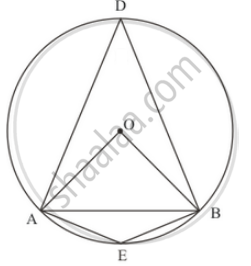Advertisements
Advertisements
Question
A chord of a circle is equal to the radius of the circle. Find the angle subtended by the chord at a point on the minor arc and also at a point on the major arc.
Solution
We have to find `angleADB` and `angle AEB`

Construction: - O is centre and r is radius and given that chord is equal to radius of circle
Now in ΔAOB we have
AO = OB = BA ( It is given that chord is equal to radius of circle)
So, ΔAOB is an equilateral triangle
`angleAOB = 60°`
So,
(The angle subtended by an arc of a circle at the centre is double the angle subtended by it at any point on the remaining part of the circle)
Then `angleADB = 30°`
So,
\[\angle AEB = \frac{1}{2}\left( \text{ Reflex } \angle AOB \right)\]
\[ = \frac{1}{2}\left( 360° - 60° \right)\]
\[ = 150° \]
Therefore,
`angleADB = 30°` and `angleAEB = 150°`
Hence, the angle subtended by the chord at a point on the minor arc is 150° and also at a point on the major arc is 30°.
APPEARS IN
RELATED QUESTIONS
A line segment AB is of length 5 cm. Draw a circle of radius 4 cm passing through A and B. Can you draw a circle of radius 2 cm passing through A and B? Give reason in support of your answer.
The lengths of two parallel chords of a circle are 6 cm and 8 cm. if the smaller chord is at a distance of 4 cm from the centre, what is the distance of the other chord from the centre?
Three girls Ishita, Isha and Nisha are playing a game by standing on a circle of radius 20 m drawn in a park. Ishita throws a ball o Isha, Isha to Nisha and Nisha to Ishita. If the distance between Ishita and Isha and between Isha and Nisha is 24 m each, what is the distance between Ishita and Nisha.
If the perpendicular bisector of a chord AB of a circle PXAQBY intersects the circle at P and Q, prove that arc PXA ≅ arc PYB.
A, B and C are three points on a circle. Prove that the perpendicular bisectors of AB, BC and CA are concurrent.
If BM and CN are the perpendiculars drawn on the sides AC and AB of the triangle ABC, prove that the points B, C, M and N are concyclic.
Two circles with centres O and O′ intersect at two points A and B. A line PQ is drawn parallel to OO′ through A(or B) intersecting the circles at P and Q. Prove that PQ = 2 OO′.
